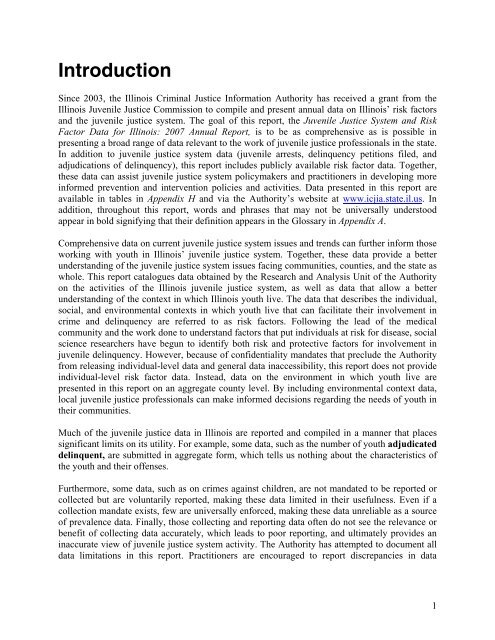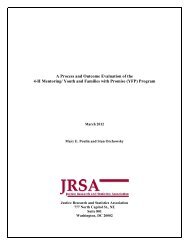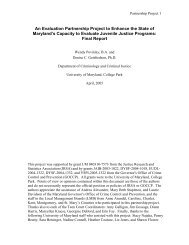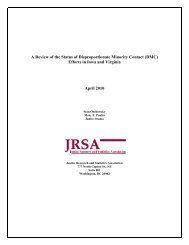Juvenile Justice System and Risk Factor Data - Illinois Criminal ...
Juvenile Justice System and Risk Factor Data - Illinois Criminal ...
Juvenile Justice System and Risk Factor Data - Illinois Criminal ...
Create successful ePaper yourself
Turn your PDF publications into a flip-book with our unique Google optimized e-Paper software.
Introduction<br />
Since 2003, the <strong>Illinois</strong> <strong>Criminal</strong> <strong>Justice</strong> Information Authority has received a grant from the<br />
<strong>Illinois</strong> <strong>Juvenile</strong> <strong>Justice</strong> Commission to compile <strong>and</strong> present annual data on <strong>Illinois</strong>’ risk factors<br />
<strong>and</strong> the juvenile justice system. The goal of this report, the <strong>Juvenile</strong> <strong>Justice</strong> <strong>System</strong> <strong>and</strong> <strong>Risk</strong><br />
<strong>Factor</strong> <strong>Data</strong> for <strong>Illinois</strong>: 2007 Annual Report, is to be as comprehensive as is possible in<br />
presenting a broad range of data relevant to the work of juvenile justice professionals in the state.<br />
In addition to juvenile justice system data (juvenile arrests, delinquency petitions filed, <strong>and</strong><br />
adjudications of delinquency), this report includes publicly available risk factor data. Together,<br />
these data can assist juvenile justice system policymakers <strong>and</strong> practitioners in developing more<br />
informed prevention <strong>and</strong> intervention policies <strong>and</strong> activities. <strong>Data</strong> presented in this report are<br />
available in tables in Appendix H <strong>and</strong> via the Authority’s website at www.icjia.state.il.us. In<br />
addition, throughout this report, words <strong>and</strong> phrases that may not be universally understood<br />
appear in bold signifying that their definition appears in the Glossary in Appendix A.<br />
Comprehensive data on current juvenile justice system issues <strong>and</strong> trends can further inform those<br />
working with youth in <strong>Illinois</strong>’ juvenile justice system. Together, these data provide a better<br />
underst<strong>and</strong>ing of the juvenile justice system issues facing communities, counties, <strong>and</strong> the state as<br />
whole. This report catalogues data obtained by the Research <strong>and</strong> Analysis Unit of the Authority<br />
on the activities of the <strong>Illinois</strong> juvenile justice system, as well as data that allow a better<br />
underst<strong>and</strong>ing of the context in which <strong>Illinois</strong> youth live. The data that describes the individual,<br />
social, <strong>and</strong> environmental contexts in which youth live that can facilitate their involvement in<br />
crime <strong>and</strong> delinquency are referred to as risk factors. Following the lead of the medical<br />
community <strong>and</strong> the work done to underst<strong>and</strong> factors that put individuals at risk for disease, social<br />
science researchers have begun to identify both risk <strong>and</strong> protective factors for involvement in<br />
juvenile delinquency. However, because of confidentiality m<strong>and</strong>ates that preclude the Authority<br />
from releasing individual-level data <strong>and</strong> general data inaccessibility, this report does not provide<br />
individual-level risk factor data. Instead, data on the environment in which youth live are<br />
presented in this report on an aggregate county level. By including environmental context data,<br />
local juvenile justice professionals can make informed decisions regarding the needs of youth in<br />
their communities.<br />
Much of the juvenile justice data in <strong>Illinois</strong> are reported <strong>and</strong> compiled in a manner that places<br />
significant limits on its utility. For example, some data, such as the number of youth adjudicated<br />
delinquent, are submitted in aggregate form, which tells us nothing about the characteristics of<br />
the youth <strong>and</strong> their offenses.<br />
Furthermore, some data, such as on crimes against children, are not m<strong>and</strong>ated to be reported or<br />
collected but are voluntarily reported, making these data limited in their usefulness. Even if a<br />
collection m<strong>and</strong>ate exists, few are universally enforced, making these data unreliable as a source<br />
of prevalence data. Finally, those collecting <strong>and</strong> reporting data often do not see the relevance or<br />
benefit of collecting data accurately, which leads to poor reporting, <strong>and</strong> ultimately provides an<br />
inaccurate view of juvenile justice system activity. The Authority has attempted to document all<br />
data limitations in this report. Practitioners are encouraged to report discrepancies in data<br />
1

















